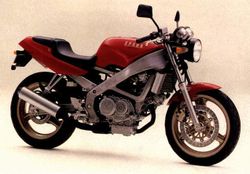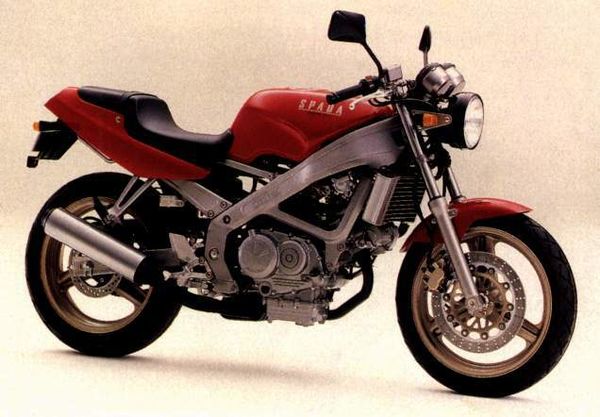Honda VT250 Spada
 |
|
| Honda VT250 Spada | |
| Manufacturer | |
|---|---|
| Also called | VT 250 Spada |
| Production | 1988-89 |
| Class | Cruiser |
| Engine | Four stroke, V-Twin, DOHC, 4 valves per cylinder |
| Compression ratio | 11.0:1 |
| Ignition | Transistorized |
| Transmission | 6 Speed |
| Suspension | Front: 37 mm Telescopic forks Rear: Monoshock with 7-step preload adjustment |
| Brakes | Front: Single disc 2 piston caliper Rear: Drum |
| Front Tire | 100/80-17 |
| Rear Tire | 140/70 -17 |
| Seat Height | 740 mm / 29.1 in |
| Weight | 149 kg / 328 lb (dry), |
| Recommended Oil | Honda GN4 10W-40 |
| Fuel Capacity | 11 Liters |
| Manuals | Service Manual |
Engine[edit | edit source]
The engine was a Liquid cooledZ cooled Four stroke, V-Twin, DOHC, 4 valves per cylinder. The engine featured a 11.0:1 compression ratio.
Chassis[edit | edit source]
It came with a 100/80-17 front tire and a 140/70 -17 rear tire. Stopping was achieved via Single disc 2 piston caliper in the front and a Drum in the rear. The front suspension was a 37 mm Telescopic forks while the rear was equipped with a Monoshock with 7-step preload adjustment. The VT250 Spada was fitted with a 11 Liters fuel tank. The bike weighed just 149 kg / 328 lb.
Photos[edit | edit source]
Overview[edit | edit source]
Honda VT 250L Spada
Honda's VT250 Spada lightweight motorcycle features a
diecast aluminum box-section frame, which the manufacturer claims to be the
world's first application of such design and construction. The company's own
Italian subsidiary has been producing a smaller model, the NSR125, which also
has a cast aluminum frame, however, it has open-sectioned members.
Among the merits of this frame design that Honda cites are lighter weight, by three kg, and improved lateral and torsional stiffnesses, by 22 and 25% respectively, as compared with the predecessor model which had a welded steel frame. The "CASTEC" (Honda CASTing frame TEChnology) allows more freedom in design and styling by varying section sizes, thicknesses, and shapes of the main frame members. The CASTEC frame also improves productivity as it entails less welding length (now two meters in total as compared with the previous design's three meters).
The frame consists of two hollow, box-section side members which are gravity diecast, with four attachments. Diecast members are welded together at the front seams via a GDC (gravity diecast) rear cross-brace. A mid-section GDC seat-support is bolted onto the side members, and contributes to the frame's rigidity. Every stress-carrying GDC frame component is presently X-ray checked for possible casting flaws; however, Honda believes that spot checks should suffice as quality data are accumulated. The frame surfaces are shot-peened. The frame is then heat-treated and finally coated.
New CASTEC cast aluminum frame adopted in the updated VT250 motorcycle.
| Year | 1988-89 |
|---|---|
| Engine Type | Four stroke, V-Twin, DOHC, 4 valves per cylinder |
| Displacement | 249 cc / 15.2 cu-in |
| Bore X Stroke | 60 x 44.1 mm |
| Cooling System | Liquid cooledZ |
| Compression | 11.0:1 |
| Induction | 2x 32mm Keihin VD10F carburetors |
| Ignition | Transistorized |
| Starting | Electric |
| Max Power | 40 hp / 29.8 kW @ 12000 rpm |
| Max Torque | 25.4 Nm / 18.8 lbf·ft @ 9000 rpm |
| Transmission | 6 Speed |
| Final Drive | Chain |
| Gear Ratio | 1st gear 2.733 / 2nd gear 2.000 / 3rd gear 1.590 / 4th gear 1.333 / 5 speed 1.153 6 speed 1.035 |
| Front Suspension | 37 mm Telescopic forks |
| Front Travel | 120 mm / 4.7 in |
| Rear Suspension | Monoshock with 7-step preload adjustment |
| Front Brakes | Single disc 2 piston caliper |
| Rear Brakes | Drum |
| Front Tire | 100/80-17 |
| Rear Tire | 140/70 -17 |
| Dimensions | Length 2010 mm / 79 in Width 715 mm / 28.1 in Height 1,020 mm / 40 in |
| Wheel Base | 1380 mm / 54 in |
| Seat Height | 740 mm / 29.1 in |
| Ground Clearance | 150 mm / 5.9 in |
| Dry Weight | 149 kg / 328 lb |
| Fuel Capacity | 11 Liters |
